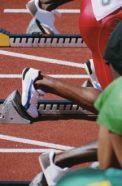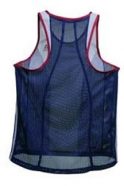Surviving Olympic Heat
Athletes competing in the Athens Olympic Games will rely on training and new technology to cope with high temperatures.
By Emily Sohn
It’s going to be hot over there.
At this summer’s Olympic Games in Athens, temperatures will soar into the 90s. The air will be humid, sticky, and laden with pollution. It’ll be hard to breathe, hard to stay cool, hard to keep hydrated. And that’s just what the fans will have to face. Imagine trying to race a bicycle or run a marathon under such harsh conditions.
 |
|
Athletes are preparing for high temperatures at the 2004 Olympics Games, coming up this summer in Athens.
|
For months, elite athletes have been preparing for the heat in Athens. Their coaches hope that a fine-tuned balance of training techniques and technology will help them perform as efficiently as possible without overheating.
Some athletes have practiced their sport in heated rooms. Many will wear clothes, helmets, and other gear that’s specially designed to keep them cool. They’ll drink fluids before, during, and after their events.
The games run from Aug. 13 to Aug. 29, 2004.
Warming up
Exercising in any kind of weather warms you up. That’s because muscles release heat as they work. Think about how hot you get when you walk up a steep hill or run around for a while.
For every 15 to 30 minutes of consistent exercise, an athlete’s core body temperature rises about half a degree, says Mark Verstegen. He’s founder and director of Athletes’ Performance, a training facility in Tempe, Ariz.
 |
|
Built for the first modern Olympics Games in 1896, the Panathinaikon Stadium in Athens will be used during the 2004 Olympic Games for archery and the finish of the marathon run.
|
| I. Peterson |
Such a temperature rise can feel good if it’s cool outside. When it’s hot, though, exercise can be a drag for many people.
Your body functions best with a core temperature of about 98.6 degrees F., and it works hard to stay there. You shiver when it’s cold, and the motion helps warm you up. You sweat when it’s hot, and the evaporation cools you off.
But this system works only up to a certain point, says engineer Christian DiBenedetto. He leads a research team in Portland, Ore., at the headquarters of Adidas, an athletic gear company.
The body’s cooling system is at its best when your body glistens with sweat but no droplets form. “When droplets run down your body, taking layers of sweat with them, you’re not dissipating heat as effectively,” DiBenedetto says. “You aren’t as cool as you could be.”
In many hot places, people nap during the heat of the afternoon, or they sit on the porch drinking lemonade. For Olympic athletes, relaxation is not an option. Rain, shine, or oppressive heat, they must run, jump, and play as hard as they can. Glory is at stake.
Marathon runners may face some of the biggest challenges in Athens. After more than 2 hours of heavy exertion, their core temperatures can easily reach 103 or 104 degrees, Verstegen says. “It can be almost like having the flu,” he adds. “It can be really dangerous.”
Learning to cope
When the Olympic Games were held in Mexico City in 1968, athletes had a different concern. Mexico City sits at 7,349 feet above sea level, where the air is thinner and oxygen more scarce than at sea level. To prepare, competitors had to acclimate to, or get used to, the conditions by training at altitude or traveling to Mexico City weeks before the games. With enough time, their bodies started to work better with less oxygen.
Acclimation will be important in Athens, too, not to the altitude but to the heat.
 |
|
The Olympic games were not the only athletic contests in ancient Greece. The Pythian games took place at Delphi every 4 years, 2 years after the Olympic games. The stadium where the Pythian games were held was built in the 5th century B.C., and was reconstructed in the 2nd century A.D. The stone seats could accommodate as many as 7,000 spectators. |
| I. Peterson |
It takes between 3 and 60 days for the body to adapt to new climates, Verstegen says. Then, physical changes happen. Blood vessels begin to deliver more oxygen to muscle cells. The cells themselves use energy more efficiently to produce less heat. The body gets better at cooling itself.
Without acclimation, the results can be ugly.
“It’s brutal,” Verstegen says. “Your legs feel all mushy and wobbly. It’s the sensation that you can’t dissipate enough heat. You’re using all your energy to cool your body, and you don’t have enough left over to perform.”
Granted, athletes who already live in hot places will have a slight advantage, as will people whose bodies naturally deal well with heat. Training in warm rooms and getting to Athens early will have to do for everyone else.
When it comes time for their events, athletes will have to work hard to stay hydrated. The human body is made up mostly of water, which keeps the body running smoothly. The more people sweat, the more water they lose, and the harder it becomes to perform well.
Athletes will have to drink plenty of water and sports drinks the night before they compete to make sure they begin with a full tank. If their sports allow it, they’ll also try to drink liquids every 10 to 15 minutes during their events.
New technology
Training, acclimation, and keeping hydrated can take an athlete only so far. To push the human body beyond these limits, technology often takes over.
One of the most important decisions athletes will have to make in Athens is about what to wear. And it’s not a question of fashion.
Clothing companies have put years of research into developing gear that helps the body deal with particular weather conditions. At Adidas, for instance, researchers use infrared cameras to study how both men’s and women’s body temperatures change with exercise. Scientists have identified several places on the body that release a lot of heat. These hotspots include the head, neck, shoulders, and back of the knee.
Based on their studies, Adidas engineers invented a fabric called ClimaCool, which is designed to manage sweat and help the body get rid of heat. ClimaCool is a three-dimensional mesh so that much of the fabric rides above the skin.
This creates a layer of air between the body and the fabric, DiBenedetto says. Where it touches the body, the fabric picks up sweat. The extra ventilation makes the sweat evaporate more quickly, and athletes stay cooler than they would with, say, a cotton T-shirt.
 |
|
A ClimaCool athletic shirt is made from a three-dimensional mesh fabric that readily picks up sweat.
|
| Adidas |
ClimaCool shirts, shoes, and other gear will make appearances in Athens. Some athletes will wear similar fabrics designed by other companies.
Believe it or not, lots of science can go into the clothes you wear, DiBenedetto says.
“Kids sit in science class and learn about heat, but they don’t understand how it actually applies to anything they might be interested in,” he says. “We take those same principles and apply them to the way we build apparel and footwear.”
There’ll be other types of heat-specific equipment in Athens besides clothing, Verstegen says.
For example, some athletes may end up taking advantage of the Game Ready Accelerated Recovery System for cooling the body. Inspired by NASA spacesuit technology, it consists of specially designed, computer-controlled body wraps made from a flexible fabric. The system, used in place of ice packs and elastic bandages, allows athletes to recover more quickly from sprains, strains, and other injuries.
To get rid of surplus heat, athletes can also use what is basically a personal air-conditioning unit. They wear a device that fits around the hand like a glove. Called the Rapid Thermal Exchange (RTX), it contains a water-cooled metal plate that draws excess heat from the palm of the hand. It can make an athlete’s core temperature drop in just a few minutes.
The RTX was invented by scientists at Stanford University. It has already been used by football players to cope with high temperatures when competing in places such as Arizona. Cyclists, runners, and other athletes can take advantage of it during a timeout or whenever they take a break to cool down to avoid heat exhaustion.
To win in Athens this summer, Olympic athletes will need more than skill, training, determination, and fancy fabrics. More than anything else, they’ll need to keep their cool.
Going Deeper:







